Gunatillake, T; Yong, HE; Dunk, C; Keogh, RJ; Borg, AJ; Cartwright, JE; Whitley, GS; Murthi, P
(2016)
Homeobox gene TGIF-1 is increased in placental endothelial cells of human fetal growth restriction.
Reproduction, 152 (5).
pp. 457-465.
ISSN 1741-7899
https://doi.org/10.1530/REP-16-0068
SGUL Authors: Whitley, Guy St John
![[img]](https://openaccess.sgul.ac.uk/108196/1.hassmallThumbnailVersion/REP-16-0068.full.pdf)  Preview |
|
PDF
Accepted Version
Available under License ["licenses_description_publisher" not defined].
Download (2MB)
| Preview
|
Abstract
Aberrant placental angiogenesis is associated with fetal growth restriction (FGR). In the mouse, targeted disruption of the homeobox gene, transforming growth β-induced factor (Tgif-1), which is also a transcription factor, causes defective placental vascularisation. Nevertheless, TGIF-1's role in human placental angiogenesis is unclear. We have previously reported increased TGIF-1 expression in human FGR placentae and demonstrated localisation of TGIF-1 protein in placental endothelial cells (ECs). However, its functional role remains to be investigated. In this study, we aimed to specifically compare TGIF-1 mRNA expression in placental ECs isolated from human FGR-affected pregnancies with gestation-matched control pregnancies in two independent cohorts from Australia and Canada, and to identify the functional role of TGIF-1 in placental angiogenesis using the human umbilical vein endothelial cell-derived cell line, SGHEC-7 and primary human umbilical vein ECs. Real-time PCR revealed that TGIF-1 mRNA expression was significantly increased in ECs isolated from FGR-affected placentae compared with that of controls. The functional roles of TGIF-1 were determined in ECs following TGIF-1 siRNA transfection. TGIF-1 inactivation in ECs significantly reduced TGIF-1 at both the mRNA and protein levels, as well as the proliferative and invasive potential, but significantly increased the angiogenic potential. Using angiogenesis PCR screening arrays, we identified ITGAV, NRP-1, ANPGT-1 and ANPGT-2 as novel downstream targets of TGIF-1, following TGIF-1 inactivation in ECs. Collectively, these results show that increased TGIF-1 in FGR may regulate EC function through mediating the expression of angiogenic molecules and contribute to aberrant placental angiogenesis in FGR pregnancies.
Statistics
Item downloaded times since 07 Sep 2016.
Actions (login required)
 |
Edit Item |



